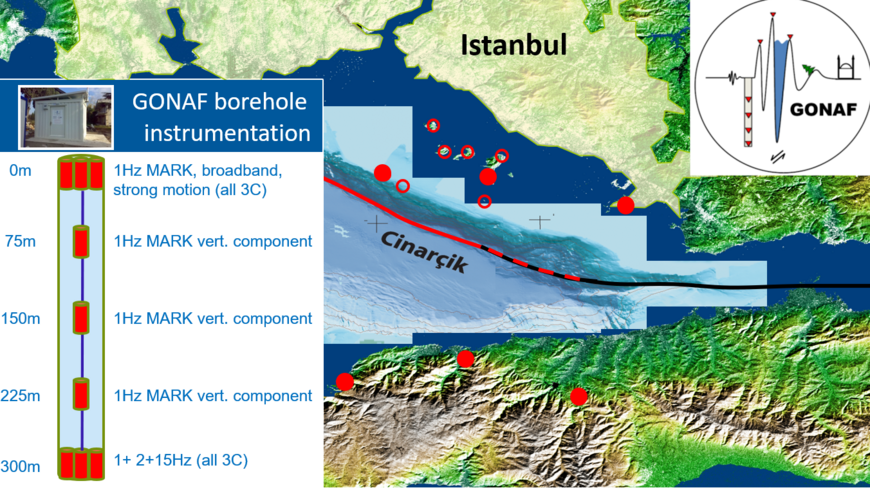Geophysical Observatory at the North Anatolian Fault | GONAF
Turkey
GONAF (Geophysical Observatory at the North Anatolian Fault) is a combined surface and downhole based observatory to measure tectonic deformation transients (seismic and aseismic) along the overdue Marmara segment of the North Anatolian Fault Zone (NAFZ) in northwestern Türkiye. There, a M>7 earthquake is pending in direct vicinity to the Istanbul megapolis.
The main objectives of the GONAF observatory are:
- (1) to identify potentially creeping and locked fault segments (asperities) - the latter representing a high potential for a large rupture with subsequent directivity effects and ground shaking
- (2) monitoring of deformation transients that could point towards the occurrence of a hazardous event.
The fact that the entire Marmara section of the NAFZ is under water makes high-resolution seismic and geodetic monitoring of seismicity, slow-slip events and potential creep a challenging task. The GONAF borehole-based geophysical instrumentation surrounding the eastern Sea of Marmara region was conceived and developed in the context of the International Continental Drilling Program (ICDP). Since 2015 GONAF has equipped 11 boreholes at 7 locations with borehole geophones and strainmeters, ensuring a high-resolution real-time monitoring of the Marmara seismic gap. Combining the data from GONAF stations with surface networks allowed the generation of the first high-resolution seismicity catalog covering almost 15 years (2006-2021). Among others, this catalog was employed to identify earthquake repeaters, which are earthquakes that rupture quasi-periodically the same asperities, and are typically attributed to the presence of aseismic slip.
In addition to the study of brittle failures in the form of seismic events, GONAF is also addressing the role of aseismic deformation processes through strain monitoring. These processes include fault creep and slow earthquakes, which are now recognized as playing equally fundamental roles in the seismomechanics of the Earth's crust. In this context, two transient episodes of slow slip have been observed in connection with the occurrence of M > 4 earthquakes in the region.
Description of instrumentation
GONAF (Geophysical Observatory at the North Anatolian Fault) is a combined surface and downhole based observatory to measure tectonic deformation transients (seismic and aseismic) along the overdue Marmara segment of the North Anatolian Fault Zone (NAFZ) in northwestern Türkiye. There, a M>7 earthquake is pending in direct vicinity to the Istanbul megapolis. The main objectives of the GONAF observatory are (1) to identify potentially creeping and locked fault segments (asperities) - the latter representing a high potential for a large rupture with subsequent directivity effects and ground shaking and (2) monitoring of deformation transients that could point towards the occurrence of a hazardous event.
The fact that the entire Marmara section of the NAFZ is under water makes high-resolution seismic and geodetic monitoring of seismicity, slow-slip events and potential creep a challenging task. The GONAF borehole-based geophysical instrumentation surrounding the eastern Sea of Marmara region was conceived and developed in the context of the International Continental Drilling Program (ICDP). Since 2015 GONAF has equipped 11 boreholes at 7 locations with borehole geophones and strainmeters, ensuring a high-resolution real-time monitoring of the Marmara seismic gap. Combining the data from GONAF stations with surface networks allowed the generation of the first high-resolution seismicity catalog covering almost 15 years (2006-2021). Among others, this catalog was employed to identify earthquake repeaters, which are earthquakes that rupture quasi-periodically the same asperities, and are typically attributed to the presence of aseismic slip.
In addition to the study of brittle failures in the form of seismic events, GONAF is also addressing the role of aseismic deformation processes through strain monitoring. These processes include fault creep and slow earthquakes, which are now recognized as playing equally fundamental roles in the seismomechanics of the Earth's crust. In this context, two transient episodes of slow slip have been observed in connection with the occurrence of M > 4 earthquakes in the region.

Website of the Observatory and Data Access
Data access for GONAF is described on the observatory webpage https://www.gonaf-network.org/
Catalogues derived partially from GONAF data:
- AFAD Earthquake catalogue: Prime Ministry, Disaster and Emergency Management Presidency, Earthquake Department, On-line Catalogue, www.deprem.gov.tr, 2007–present.
- Martínez-Garzón, P., Durand, V., Kwiatek, G., Bohnhoff, M., Georg, D., Turkmen, T., Nurlu, M.: Seismicity catalog for the Armutlu Peninsula from 2019 derived using the SMARTnet temporary seismic network. V. 1. GFZ Data Services. https://doi.org/10.5880/GFZ.4.2.2021.004, 2021.
- Bentz, S., Kwiatek, G., Durand, V., Wollin, C., Bohnhoff, M., Martínez Garzón, P.: Earthquake catalog derived from Template Matching related to "A two-scale preparation phase preceded a Mw 5.8 Earthquake in the Sea of Marmara offshore Istanbul, Turkey". https://doi.org/10.5880/GFZ.4.2.2020.006, 2020.


